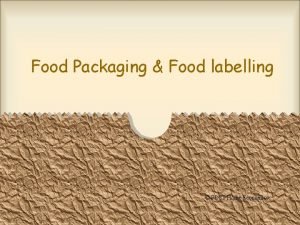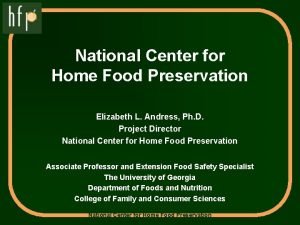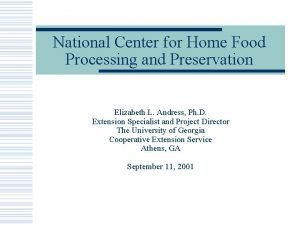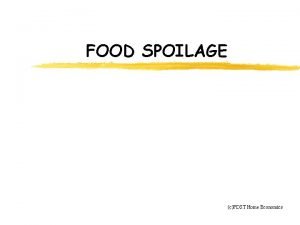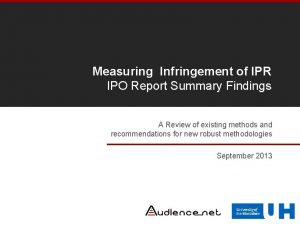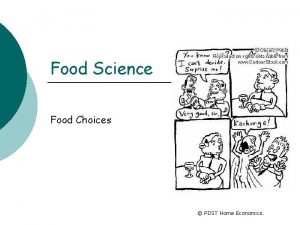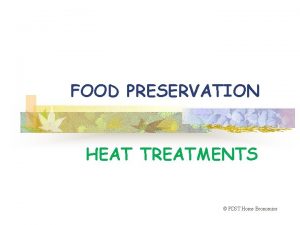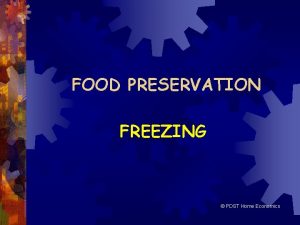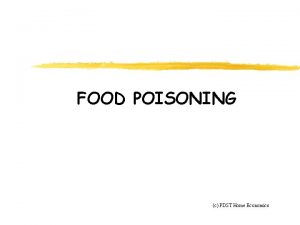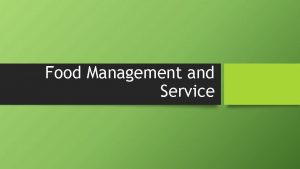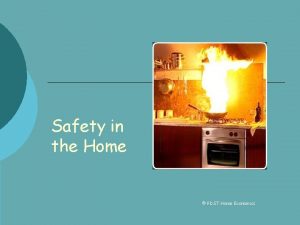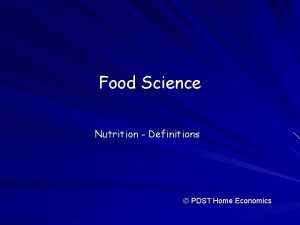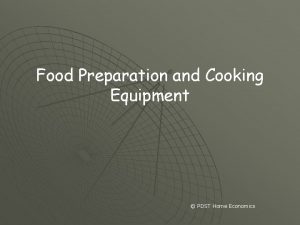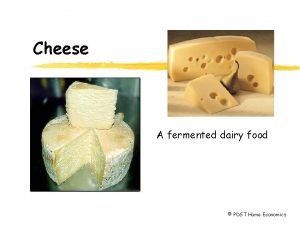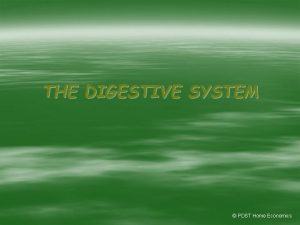FOOD PRESERVATION COMMERCIAL PRESERVATION PDST Home Economics COMMERCIAL













- Slides: 13

FOOD PRESERVATION COMMERCIAL PRESERVATION © PDST Home Economics

COMMERCIAL FREEZING • Blast Freezing: Food passed through tunnel on conveyor belt and cold air (-30ºC) is blown over it. Suitable for most food. • Plate or Contact Freezing: Food is pressed between 2 cold metal surfaces. Used for thin foods e. g. burgers, fish fillets or fingers, chops.

COMMERCIAL FREEZING • Flow Freezing: Food passes through a tunnel on a perforated conveyor belt. Freezing air is blown from underneath and freezes each piece of food separately so they don’t stick together e. g. peas, berries etc.

COMMERCIAL HEAT TREATMENTS • Canning/ Bottling, Pasteurisation, Sterilisation and UHT

CANNING / BOTTLING • Fruit, vegetables, meat, fish, soup, stew. • Principles: (a) Heat destroys enzymes and microbes (b) Sealing in an airtight container prevents recontamination. • Method: Preparation of food - Vegetables blanched & meat cooked. Cans filled with food + liquid (syrup, brine, sauce). Air removed. Air tight seal. Sterilised. Cans cooled & labelled.

CANNING / BOTTLING • High acid foods: e. g. Fruit need fast heat treatment - 100°C for <30 min. • Low acid foods: e. g. Meat need higher temp and longer time - 115 °C for >30 min. • Cans are lacquered on inside to prevent reaction between food and metal. • Aseptic canning : Food and cans are sterilised separately at ultra high temperatures. The cans are filled, sealed, cooled and labelled. High temp means less time involved so less damage to food. Also used for large cans of food.

CANNING / BOTTLING • Don’t buy bulging, dented or rusted tins. • Remove food from can once opened and use quickly. • Bottling same as canning except glass containers used e. g. ketchup, sauces, mayonnaise.

COMMERCIAL CHEMICAL PRESERVATION • Chemical preservation means the addition of preservatives to food to prevent enzyme and microbial activity. • Chemicals used are: salt, sugar, sulphur dioxide, sorbic acid, antioxidants, alcohol and acid e. g. vinegar.

PRINCIPLES OF CHEMICAL PRESERVATION • Most chemicals work by dissolving in water of the food cells forming a concentrated solution. Microbial cells are dehydrated by osmosis and die. • Alcohol denatures the protein in the microbial cells and destroys them. • Acids lower the p. H of the food making it an unsuitable environment for enzyme or microbial activity.

COMMERCIAL DEHYDRATION • Principle: Microbes need water. Dehydration removes the water from the food stopping microbial growth. • Methods: Sun drying e. g. tomatoes, Spray drying e. g. milk, Roller drying e. g. breakfast cereals, Accelerated freeze drying (AFD) AFD=Food frozen @ low temp. Tiny ice crystals then evaporated in vacuum chamber (sublimation). Advantages: Lightweight foods. Less heat needed so better flavour & nutritive value. Longer shelf life e. g. coffee, fruit,

(H. L) IRRADIATION Radiation is used to destroy microorganisms in food Advantages • Destroys microbes and • other parasites. • Longer shelf life • • Slows ripening and • sprouting • No effect on colour, flavour, texture • • No need for chemicals • Disadvantages Not suitable for high fat food- rancidity Loss of vitamins High levels of radiation needed for some microbes Public are concerned May be used to disguise poor products

(H. L) EFFECTS OF PRESERVATION • • Freezing Microbes and enzymes inactivated Some loss Vit. B 1 and C on thawing Loss of texture especially if frozen slowly Possible freezer burn • • • Canning Microbes and enzymes destroyed Vit. B and C destroyed by heat Food cooked Loss of colour, flavour & texture Canning liquid affects nutritive value- salt, fat or sugar content

EFFECTS OF DRYING ON FOOD • Microbes destroyed • Water removed • Water soluble Vit. B & C lost • Changes in shape, weight, colour, texture of food
 Pdst home economics
Pdst home economics Pdst home economics
Pdst home economics Pdst home economics
Pdst home economics Pdst economics
Pdst economics National center for home preservation
National center for home preservation National center for home preservation
National center for home preservation She said that, home economics stands for the ideal home.
She said that, home economics stands for the ideal home. Noncommercial food service
Noncommercial food service Reasons for food spoilage
Reasons for food spoilage Report writing pdst
Report writing pdst Ciara o'donnell pdst
Ciara o'donnell pdst Pdst ipo
Pdst ipo Lcvp summary report sample
Lcvp summary report sample Www.pdst.ie
Www.pdst.ie

